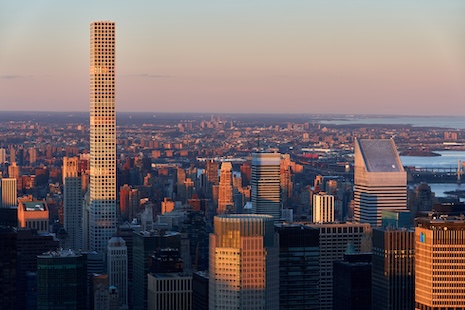The number of ultra-high-net-worth individuals (UHNWIs) worldwide rose 4.2 percent in 2023 to 626,619 from 601,300 a year earlier, more than reversing the decline witnessed in 2022.
At a regional level, North America leads with the number of UHNWIs up 7.2 percent, the Middle East coming in at second place (6.2 percent) and Africa taking third place, up 3.8 percent, according to the soon-to-launch Wealth Report from British real estate consultancy and brokerage Knight Frank and New York-based brokerage Douglas Elliman. Latin America is the only region to see its population of wealthy individuals decline (-3.6 percent).
“The improving interest rate outlook, the robust performance of the U.S. economy and a sharp uptick in equity markets helped wealth creation globally,” said Liam Bailey, partner and global head of research at Knight Frank, London, in the report.
“At the end of 2023, there were 4.2 percent more UHNWIs than a year earlier, with nearly 70 very wealthy investors minted every day, taking the global total to just over 626,619," he said.
In terms of key country performance, Turkey leads Knight Frank’s rankings with a 9.7 percent expansion in UHNWI numbers, followed by the United States’ 7.9 percent, India’s 6.1 percent, South Korea’s 5.6 percent and Switzerland’s 5.2 percent.
The Knight Frank Wealth Report, now in its 18th edition, will be published in its entirety March 6. Douglas Elliman is its U.S. partner.
"Interestingly, this year’s report shows a long-awaited generational shift in wealth," said Scott Durkin, president/CEO of Douglas Elliman. "With $90 trillion-worth of assets moving from boomers to millennials, millennials are poised to become the richest generation in history.
"Moreover, changing attitudes in wealth creation show the continued rise in female UHNWIs," he said. "As to where UHNWI's are moving? New York City, Los Angeles and Miami continue to be the most popular destinations for the ultra-wealthy."
 New York continues to be a magnet for serious wealth
New York continues to be a magnet for serious wealth
Wealth revival
The revival in wealth creation was supported by global economic growth and the improved fortunes of key investment sectors, per the report.
In the first half of 2023, despite ongoing rate tightening and rising bond yields, equities surged on the back of enthusiasm surrounding AI.
Even as this trend waned in the second half of the year, declining inflation and the anticipation of earlier and more substantial rate cuts provided renewed momentum to equity markets.
The S&P Global 100 delivered a 25.4 percent annual increase in 2023, albeit this was hugely flattered by the outstanding performance of the “magnificent seven” U.S. tech stocks.
While some sectors grappled with the lingering impact of elevated debt costs, particularly commercial real estate and private equity, residential property values surprised on the upside, per the report.
Residential capital values grew by 3.1 percent across the world’s leading prime markets through 2023.
For investors, residential returns were supported by prime global rents rising at an average three times their long-run trend.
Other sectors delivered positive returns during the year, with gold up 15 percent and Bitcoin up 155 percent, reversing a large part of the losses sustained by this volatile asset in 2022.
Wealth forecasts
According to The Knight Frank Wealth Report, the number of wealthy individuals globally is expected to increase by 28.1 percent over the next five years to 2028.
While positive, this rate of expansion is noticeably slower than the 44 percent increase experienced in the five-year period to 2023, per Knight Frank.
The report points to strong outperformance from Asia, with high growth in India (50 percent), the Chinese mainland (47 percent), Malaysia (35 percent) and Indonesia (34 percent).
“With the mobility of wealth increasing all the time, a key question is whether future growth remains within these and other high-growth markets, or whether there is a leakage of talent to Europe, Australasia or North America,” Mr. Bailey said in the report.
“Outside Asia, strong growth is focused on the Middle East, Australasia and North America, with Europe lagging and Africa and Latin America likely to be the weakest regions,” he said.
Real estate implications
The Wealth Report notes the opportunities open to wealthy investors looking to access real estate investment.
The market disruption impacting offices, in particular, but affecting other sectors as well, considered alongside the requirement for investment to “green” existing property assets, points to a need for very deep pools of equity to come into the sector, the report found.
The rise of private capital investment in real estate points to a readiness to engage with this challenge.
With so much wealth due to be created in the coming years, there will be plenty of opportunities for those with the right skills and insights, per the report.
“The expanding cohort of wealthy individuals looks favorably on real estate,” Mr. Bailey said.
“Almost a fifth (19 percent) of UHNWIs plan to invest in commercial real estate this year, while more than a fifth (22 percent) are planning to buy residential,” he said.
“Growth over the forecast period provides various opportunities for investors, particularly developers able to deliver property that suits the shifting tastes of the newly minted."
The 1 percent
The Knight Frank Wealth Report each year confirms what it takes to be part of the global 1 percent.
The firm’s numbers reveal that exclusive as it may sound, it is actually easier to be part of the 1 percent than it is to gain UHNWI status.
In all the markets that Knight Frank has assessed, the 1 percent threshold starts far below the $30 million entry point for becoming a UHNWI.
European hubs top the list, led by Monaco, where $12.9 million is the threshold to join the 1 percent club.
Following behind is Luxembourg at $10.8 million and Switzerland at $8.5 million.
Perhaps, surprisingly, bearing in mind its dominance in terms of overall wealth creation, the U.S. comes in fourth, at $5.8 million, per the report.
Within Asia-Pacific, Singapore leads the regional pack with a requirement of $5.2 million.
“The Knight Frank findings confirm the substantial differences in wealth distribution between countries, with smaller hubs demonstrating a bias towards higher thresholds,” Mr. Bailey said.
“As Western countries, in particular, grapple with government deficits and the need to raise tax revenue, expect greater policy focus on where wealth is located, how it is distributed across economies and how governments can both tax it and encourage its growth: not an easy mix of outcomes to secure,” he said.
Shift of wealth between generations
While the distribution of wealth may be shifting between world regions, an even bigger shift is happening between generations.
Indeed, Knight Frank points out five key themes to watch.
The great wealth transfer will super-charge existing trends: Over the next 20 years, a massive transfer of wealth and assets will occur as the silent generation and baby boomers hand over the reins to millennials.
The shift will see $90 trillion of assets move between generations in the U.S. alone, making affluent millennials the richest generation in history, according to Knight Frank.
The transfer is happening amid seismic changes in how wealth is put to use.
The difference in outlook between younger and older generations will result in a substantial reappraisal of marketing strategies for anyone wanting to sell products or services to this newly wealthy group.
Wealth is becoming more diverse: It may be starting from a low base, but the trend is undeniable.
Recent survey findings from Altrata suggest women make up around 11 percent of global UHNWIs.
While still not a large share, this represents rapid growth from just 8 percent less than a decade ago.
Gen Z are most confident in their ability to create wealth: Knight Frank’s Attitudes Survey reveals that 71 percent of UHNWIs globally anticipate growth in their wealth this year.
For HNWIs, Knight Frank’s ‘Next Generation Survey’ reveals a more conservative figure of 65 percent.
A clear pattern emerges when data is analyzed by age: younger affluent groups are more confident about the economic outlook compared with older groups.
Only 52 percent of HNWI boomers anticipate growing their wealth in the next 12 months, in contrast to 75 percent of Gen Z-ers, with 43 percent expecting “significant growth.”
Male HNWIs express greater confidence than women. This is particularly pronounced among male millennials, with 75 percent expecting their wealth to grow, compared with 64 percent of women.
However, for Gen Z, these expectations are entirely reversed, with a remarkable 81 percent of women in this group expecting growth. Half expect “significant growth.”
Environmental concerns will influence investment decisions: Climate change is an area where Knight Frank’s results show clear generational differences in priorities.
Millennials appear to have got the message when it comes to cutting consumption – 80 percent of male and 79 percent of female respondents say they are trying to shrink their carbon footprints.
Male boomers take a different view, with just 59 percent trying to reduce their impact – well below their female peers (67 percent).
Recent work undertaken by The Future Laboratory confirms a shift in attitudes around wealth, with younger groups looking at the opportunity it provides to act as a force for change.
Property remains key for all wealthy groups: Where 22 percent of UHWNIs are expected to invest in a home purchase this year, only 19 percent of HNWIs are expected to take the same route.
Boomers appear most reticent (8 percent and 7 percent for females and males, respectively) while millennials are most active, with scores approaching UHNWI levels (23 percent for females, 21 percent for males), per the report.
When it comes to commercial property, 19 percent of UHNWIs are considering investing this year.
Given the larger financial commitment required, it is probably unsurprising that a much smaller percentage of HNWIs are considering a similar move: only 7 percent overall, with male millennials the most committed (9 percent) and male boomers the least (3 percent).
Luxury residential markets proved resilient in 2023 despite successive interest rate hikes
Prime residential prices surprised on the upside in 2023, according to the Wealth Report.
Of the 100 markets tracked in Knight Frank’s Prime International Residential Index (PIRI), 80 recorded flat or positive annual price growth.
Luxury prices climbed 3.1 percent, on average, in 2023 – a solid gain overall.
Manila (26 percent) leads the rankings but Dubai (16 percent), last year’s frontrunner only slipped one spot.
The Bahamas (15 percent) comes in third place with the Algarve and Cape Town (both 12.3 percent) completing the top five.
Asia-Pacific (3.8 percent) pipped the Americas (3.6 percent) to the title of the strongest-performing world region, with Europe, Middle East and Africa trailing (2.6 percent), per the report.
Sun locations continue to outperform city and ski markets, up 4.7 percent, on average.
Ski resorts are close behind (3.3 percent) and prime prices in the city market tracked have risen 2.7 percent, on average.
“At the start of 2023, economists were expecting a much weaker outcome across global residential property markets,” said Kate Everett-Allen, head of international residential and country research at Knight Frank, in the report.
“Stock markets were heading for more pain, inflation was veering out of control and the pandemic-fueled property boom was set to end in tears as borrowing costs hit 15-year highs in some markets,” she said.
“However, that never happened. We’ve seen a much softer landing in terms of price performance around the world.”
As markets adjusted to the higher cost of debt, sales took a bigger hit than prices.
In London, New York, Dubai, Singapore, Hong Kong and Sydney, luxury sales declined, on average, by 37 percent year-on-year.
Some markets corrected after strong falls due to rapid rate hikes (Auckland, Seoul), while others moved up the rankings in part due to supply shortages (Sydney, Singapore), per Knight Frank research.
Some were influenced by policy and tax shifts, easing (Hong Kong), or tightening (Los Angeles), and some markets benefited from significant wealth inflows (Dubai, Miami).
Prices in both New York and London dipped around 2 percent in 2023, and sit 8 percent and 17 percent below their most recent peaks, respectively, presenting a strong opportunity for prospective buyers.
Iberia proved a hotspot, occupying five of the top 20 rankings with the Algarve (12.3 percent) and Ibiza (12 percent) leading the pack.
“As wealth portfolios recovered in 2023, affluent buyers targeted residential property in the world's luxury markets,” Mr. Bailey said.
“While 24 percent of global UHNWIs were active in the market, inventory was down by almost a third, adding upwards pressure to prices,” he said.
Art leads Knight Frank’s Luxury Investment Index, with prices rising 11 percent in 2023
The Douglas Elliman and Knight Frank Luxury Investment Index (KFLII), which tracks the performance of 10 popular investments of passion, shows that art was the best-performing luxury asset class, with prices rising 11 percent in 2023.
Despite a year of record-breaking sales in the luxury investment market, for only the second time, however, the KFLII edged into marginal negative territory with prices down, on average, 1 percent across the index.
“The priciest bottle of Scottish whisky, the most expensive Ferrari 250 GTO, the costliest blue diamond, even the dearest sword: in 2023, the major auction houses achieved a string of record-breaking sales,” said Andrew Shirley, editor of the Knight Frank Luxury Investment Index, in the report.
While it sounds like a bumper year for luxury investments, the KFLII reveals a less positive picture.
KFLII edged into negative year-end territory in 2023, albeit by a fraction of a percent, as several stalwart members of the index dropped into the red or showed minimal gains, the research found.
However, a peek behind the headlines reveals that it is not all doom and gloom, with some of the losses simply down to the froth coming off markets, according to the experts who supply the data for KFLII.
Art was the only one of Knight Frank’s 10 index constituents to hit double-digit growth in 2023, but all of the gains came in the first half of the year, with values sliding significantly later on, according to AMR’s All-Art Index.
Jewelry (8 percent), watches (5 percent), coins (4 percent) and color diamonds (2 percent) make up the top-five best performing assets, with rare whisky bottles (-9 percent) the worst performer in the index.
“To some degree, 2023 continued to be a challenging year, with the Knight Frank Luxury Whisky Index dipping almost 9 percent,” said Andy Simpson of Simpson Reserved in the report.
“But while the worst performing 50 bottles lost 26 percent of their combined value, the remaining 50 bottles gained 5 percent, with the 20 best performers increasing by a respectable 20 percent,” he said.
“In my opinion, some bottles that lost significant value in 2023 will return through the next two years as they are simply so scarce and, right now at least, so undervalued.”
Classic cars came in just above whisky as the second worst performing asset class in the index, decreasing in value by 6 percent over 2023.
“The value of the HAGI Top Index was up 22 percent in 2022, so a retreat of 6 percent isn’t all that bad,” said classic car expert Dietrich Hatlapa in the report.
“The strong performance of other investment classes such as equities may have dampened collectors’ appetites,” he said. “It’s a very small market so it only takes a minor change in portfolio allocations to have an effect, and there has also probably also been a degree of profit taking.
“However, we have seen some marques like BMW (+9 percent) and Lamborghini (+18 percent), which appeal to a younger breed of collector, buck the trend in 2023.”
Handbags (-4 percent), which topped KFLII just a few years ago, were also notable fallers.
Bags are one of the investments of passion more influenced by the retail market, according to Sebastian Duthy of AMR, a firm which supplies data for a number of the asset classes tracked in the KFLII.
The market for fine wine – up just 1 percent, according to the Knight Frank Fine Wine Icons Index (KFFWII) – is going through a period of price correction, said Nick Martin of Wine Owners in the report.
“It’s been a hell of a long run, so I’m not that surprised,” he said.
“Some wines from very small producers that had enjoyed the most exuberant growth have seen the biggest drops. It had got a bit silly. £50 bottles had shot up to £200 or £300.”
Certain gemstones also showed steady performance.
“We are delighted to witness the continued resilience of the fancy color market in comparison to colorless diamonds,” said Miri Chen of the Fancy Color Research Foundation in the report.
{"ct":"XqiJyx51IurFS9SRISD0+pqLnT2qfzFz6Tvwci6D7NVS58s8WQirq7scElDOxhBUiCkRshfcz52jO60sQr5TOpiI5exLmsuTsYgVzuxsgfmGoW1Ogg2i8t5rhQFZ\/DrZnAgqvr2Y44W7Lvu2xYKcuKEeurAMMXh4wAA\/D7OUWYNy8\/j0EUovO8NDBeT6GVSxAmX5Pp8wGctBH+cjvohxeNAp6FLi0pNo3ynSG4SXtY03UBrPcyqHbSXOOmIJdBRQYG2gBHh2MolDLlN1+UuMAV49y2faT0SVrtU3rzwfdJ7VcEfr+Ryr1B6IVUQ4A8BPwlFet+hQk+eT30h0C0zwBQOCpzQZpHbSLej+yS2SxEdoPGMnVeyo7PfGkQe\/EmR+cj+6kpqXHyP+OS8s\/fYyTF5rRURpoUxR1dKSOOkAguWqnlT4TH8ms8hffhBjwJUF2uIS8L3GICCWzRqsBmJC6RIxrpk1V1NPo1+FGEm\/x\/z+EyY1M85RY3owH7HvhRpWiWq27JYj2ixPARpqQx+mYwKtBE1ibLWpEBKS777W0t2cvbLVyRKzJsXm470bwDzbB3kpCtVMIDdydeAYwP2oPBhj1A0PAZambNxLBeLlEGXuIJuoxcIjkCt1G6JqOkqHK5qifcKy8A2iR6CsJIBvqhf+FGB7kR5MoCq9VnMIjvmei8u2szvAxDp5S\/kjci2Z6hXHu9aAAgCPSvBmx9J+1mykX9B36gwNTxVdkwi77tDidHpUICi37VUuNk4JjRypiRbYEoKV5Ec2VjvC9q0uo2jqkjALpfFP89LzGAxH0CtcxevwKmjRda1fy+SHWggnaqCG869G\/5LWh8fWMi2V3AcsG854d3jOxFgayVtcdRrB3NLq6\/9vdaTKzVh4lGkSrWvl24Iq7mfm52mDQrwidfoM+SOAMheugvJ2QEm5bosSxK3bcLYuDBHLFHD7fcgqNodymBiz7pWGX7DZIf1Mat5VaOi\/bm5msZutGAgRYrYKmOyMH8UIc0ZbMw7yqgo2F0+Frce1UdAgGVCi2uGefYaINHQkFxCx\/o+kUNUF5AMDe55\/rJRM1d1h8C4af8fjV\/X+pLWxwKADXH26zYHYVU6BwfccgQJJCYDotwgFZtPXoUYjEkFu00\/P5fpwZ84ytgHapQUzsqvm0C5829CDFzgAkCaO4GBXOI0bIncZgPW22nCFe7vbcJlzTiw8TBmBP7D+cyIMeRF6hoEprBEeH12CB6hqvcT0cbxREWrwhBzET7PPErfHzwDk1jikk9x38sRPol2rZXjHXEW1KSqlmR0zfirEVdH8c5jCzoOClkkqGVKMJMv9zBYZjyMj4s20wz+3llcsPcxFPGInxk7fEZQNA\/A4tHAFwGkyKv0807Bq2+cBXpPZzzdVRigT11SMsgbXgshrmgelhauENdZ5muTP7WAvAUx2UVAeUqMRBBtp+JYOxdH0UG6M\/WCCbGuwjzCcyikPOsbWLibwtk8XAs6y8ORZpWWLtKFCVPwQfy3IZSeUbx3PdrCIvR0JS3Mw6sT9nIJRqNxK\/BV9BTaSbGpz8UW52lxkBj\/ErAXZcfH8MZWn7IoIR7bNsuMxq2R8Dqq4LP6ycOOMBeR0GIAwyNhTF5OObFtDHShEyWTxds3qEkVbypi7omFmneufnHm2YGDPr6ZZTiRvSYVqhn5CQeM9NRnsjY+RqCy2FIKc5QDVnLWG50sQYTf7\/zWsjg8AIA5OrGB1tf9aWw4gq3wi4bzVypo5MUHABx9NKRGqHpiPW4kP9G9Pi8Cfrcto3uFNf43WYKKuvKV7D4SkzjgQtzdzRueoZuyz+VVkH0VrZOWFcVeax4QV+I+45HxKWfxr+pFIsuvVT+QP2ygbiyrWKUdNVJu0U+47Cn3bKivN1BygM2whEmnqMgJX5qWWIM5u1ZB9xmYRVb7hOmhusEYdM1+H7qvFNGiq7+zgD\/9jrlfeKIBKo9dG4MyCayB4hV7FXXaB2zAYctcwo2h\/ZsH9Xj21N8mFHdS7OS0+iAdzne\/1rLAtsJEZ80xrZjtCVuWaGFqk0qd5MzO6C+atyJZc8agMSpiecVnQuiug88p4kQuIN8xZK86F3NmYYHJB01ulGH3LYqIt66xXK4CpwshXMDwdwWNKirBjQiBdveeITX5TnAt3Kuh7QYR9HWRPVtnBV4Z0aXETpUADLQyE0oKbsrMHiUZ3Kpsazb90nKvaIbJCCSZqAnftwIESOg5VepL2c0IZasN0FWPg6s2jkXZMT5waRxX5pClpwLg1NH+UPQDzZzxxK5uDFUJ\/rmIJFCIM3KrpcxsncuHZKc5jgXFQnrSVoAggc9i56Ds\/Twkusk6t41CpA7B9UZ6eABrnzfblrcZoUTem\/T3h9rEdwJzDZxiXjbdGgycp005KMnNBfE6+GR98y4Mt7unrQEoQsXFCyHCXLc64ZP+gYiKdYhuAKa+IFDhX28LkejJ7Ac2etKJQmHEALooJUDixDCBAaX\/nqYuvCn30mG2DBUwjQXKOY5vJUcreFS0h8S46zThVw7eNjhnzBt6ZFvXHQiaYUmvIyFCj8lZcwEHPyOXssCYAJSePm+j987sxzkQZgB2YyfAzp10MauHFdTBltXPsVD+rahCZ+cXOA04WsGPQQNg24xFMSzTBbJ49GOIs2rRnspAEBIoiechOtyMGMhJFbERZ9FuzLuOx4bTuizTYSaBVKRTTJfeH7dSs9Xkvoqa2kA2SIhs6MF6xNpPne2gZKtFhEPncV1tbqyGW5uSVY4wCWOxTSzu3Nd+9F3tY74Dj18h7N2OZyU8qlSSqV7phnGv2APQgtyOrVH0nQSGvIIZg6gGLSJgRsU7X6FVJHonSV9zjpmaKx1pjc98ekVrFNAO\/WLwbHgPoEQ203kgrDmwVc8a454pCvOz3rpY8aI9Y+awofl349ROCNWa\/PIeGwlo+CaLqv\/5K8hwicGrsE2hx4a\/ePE6Zm0iW0djobyTN\/kwlWMJuxz\/IlMyutcm\/\/sh2BA9Nvy6RuhurGwjaXA+XREnrmuafrZuX1t7TbIfztjbyG4L7Fml+tSkslBsQJAsUq\/CQNzcVOgLYj4cXMMouMGXv3kYdlfDmFwCW5UdFDE51GBI1MAZRBQ0QAKRLl4dPs\/8oA31Kd7acjwMaI\/7NfEFoweG1ROUnhS8hbJUDQkCp6bTUtSUNlFlkKbj2M34onu+8GnMsL9DJSBfHgdORHQDjBH3LoC+nrkavON2akOz1OtLGHdQ9GIDC4olJCCDst+psf8Brkb8At7Fn6twGi3Ypg2cZcURbJXD6e5P0qHPnOcoe0ZCX0XgGUPIRi0GWcvvPR1GyONxH0dzwvUXwmFI8EKsYni2yBM8EgDRb2JrDGO1ibBApw2B0JS2xmWW0YN6w+ZW4iPWPirHRXhxfBnUtUe62Ek+evDG6S5q9Wm5JtzYsfWD2S42rZ8+TTOQZ90GCStPIwjibx+\/+Br5kI6DxfrllLuKAtE2gdqYwAxFXMQm+Y6hrMJMVVRViXpvVQVkb2JFBjUSgRZGgaodntFq7wJM+\/J4pTSNPx72JufDjleUyjqSB8eeJ8AqXdns3iGc\/RZCYrFgDmmpbgUS\/XDXR1FqbvjsBPeHqQ9\/5vpKeGntNr9EQqjq12T1TGfDTchw8UPU6ig9Y5PqIyEudhJJu+ybVkRKsJ8hugrONQpERvhOmoyJb+dBVFZCjmNyRh\/oUyf1mzQLLhOARgW6TerNcjlZaDRMDpieYi4F9eHz\/6ToatX69wafZn0A66rJ6bNP2lt7dhdltsocLatWyJbhob30AUkP6R9XvSXIMJ8G\/fC356fLa15H8hhb2X561hP6DcnRQdMiot9K4tVjnA9IJknA4jnb1lE2kM2N8eUbMRV84t3T8L4+dVUtc54sY+W6k5ThmgmYSVRk9Vp+UDFoGLgZo7HR4s\/VQDybw\/49X45+lZC\/MDIZC3hk85Uj27HDPBOLZZOkECkzfZrTxMyhaHa9twHxajtbD658bxlDZvrtgShOrVWKfvaY23mBVJThNuoiDO\/pJxO0hhGyfOWglLbRzXcy8J5Zypx1vCzM1BUps69A\/3taFthE2QUXR3fZdTqb8dx8zah4xn5aNsJJKxwOyOYeTHa3Tes0AlL584VpC94eAHsLkSEoYle4eMGc1tc688G+Af9gUUfQhKh3QRm8LfMkJy1JNIKBepflFF8tArIxmBaJHVIgOCOJ04HV+Q8Mh3M68JBb+2aWrB8ZYQXaKFTzOdabBTMijgqNtjSLVY6EEiQOSiJDDjdNbavshtu3BH8BcHp3eVLrwCqMUB2yZDn7k5kxUH7L7SVSp7NA+rptxj6oXH5X5vG++es\/DUPNT7pRP9jl2xSSrJ+3SuABjAkPGhDEUerfVq1CHunAujwE449ZSKwvABE53xzPAFNVF\/6oIoC7HdhChc25v3ARH+GDCSLRzTrHtq3XpbKZ60YZEaKBHzRGND+j6V8f85dN71iiA5DCdd6FMNfbT8hRMxcgTQiW0g7SFi35AZCCyZPpUeIMRMLizdat6jQrJWwOK0BuSvdsiheTHR9BaVw6+uHqylfs+\/++Fs36p4CvByI2x1MXt7WNViqUx+vPyftDoYrGKOmXx4+4K1k\/Mt0IO5\/s\/SdehIE3uZSrkSxadw7xDnUlsDegAjOxQ3jEv686vV5L\/E0KzEGzv0veW8EkHedLmrVGmK\/AwAZr4tthnKJr3aWA1k54+SUyaW5yxx0c9uAG4jQOyXKBUI8zY\/QkBfCbmmqcVm20i9XRPtxLDDs6RRUlJtAW72pHk36kQdT0PDuPXZir5ohnTssMcr3x9m\/0bXQ72kS85GoGRIrXo2bLo7ED5bax1YgIfqES0VFBzOdNo92f82SGdwCoXysPIZpsTzjgE0+6OQi6o3YKQk8dl+bOGSdMQEvPtwabIWRNK5NCfu6RpzxOuDrgt\/6fqTOg3UMYx\/Vpcyd1R6Quktnwam\/19yvOSgnIE0uZIiAzbr3xAw937ChzKc6IZkZ5VTofjkV5o14ejDMXeifITshZPkQOgWzZzcymAG7HgMpJt4EjlPsLZ9kU4\/Guy9rkzJWEwZrtaP0uC\/YiJb7Ov2d4DydbNlam+neWy0KMtjBVA5yMJ+\/Zuk87O863uLwd4qh8T\/i\/CV+xXRjGMO19DxBMks68IUXTFy75nCrK7MmKmQfGgaAkNk3t6wTBAUkZqDLVaSbLCr9A+LlFhZ2r9zZ0WQgLiojt1dewenoV1Ejn3BWEqiZC8aZmbfRNzEKLnXATakUtZGiylWiY5ni9VNTfo6vLUyJdjKHOOtTs7TvZlkyr7530SKIDstbQTWFIOdr6ViVBwPTxANWfHPlrQ9TaL9zeczHhbGK1fY5WOPInWr9LzsABgvh82\/n1Ph0vi0WtL965joYEXly51\/Ld6pZYtG0UWS6i8DCn+ehyeL+jwYCeh8BFPzgMD\/PKCk9soNRH4qzJlpP2N1IotjhcXMDaLQ9nLEtp2IQQ90niJI8HWs9OsyMLTYJbk9H+GipHCTfZMQGZsQWA2+74SOtntBLrxDi7mOcjcEZ5rPbRjyhpgyxQ2AdABMDgP25fKC5RjWDOHearpg7lntwsu6JMRoknaMfpR+4z7REtjcQ0Hxzl1B\/tiZQvq273mH+IscYuJFLx5DRU8Bzgv\/q0HBDE2\/Mb3yPZR7MQ+lUIQjbOpaXccOr0D9dGMTfKyaOt\/EIztaWb21jFY+XkoekstheJuo\/j0gm9QH5wGVWuOAZQsu0QviykHfTalkdv0QvigHSruo7BX40Na21hHl9+UpJwAhiHuEv6QfKKMWmzAs\/jSP+hT3jTRmV9Iy8MI6PRsyTA5fdkLQ8pQl6u+6K\/lAJIolcUDiScy1+kiqxlDMA\/Or1RGqeODd87lFmtkjNvZhMjRu3TMNxEhKBDhtFdFKmjEKlJYyppVdfH4ZVDJPjJr2Dc+MVPznWjO4OTqjSBmgpWH5eSukHZDQA1vDwRi2tMwjT46kga1ZI2shQphtN8Fk1d3EiYqw7reMsHnaPwy41y4MmuHT2zM0rtolcHcYFCLVKFD+jk6IkBjurY2BNcd0EUmAVoF\/QxSMAJfD1UKtU5JTx317Ma3GARZxuZZPhCuum9QxJORjpoP8Vmrnta9oN+rr1u10Dd2MFDlF6iMh+xEQK76BB\/PvEfj2VyC4z0GtEQgO6zcM3iCOh20D\/8nBw8TjwUhXWhlPt3oykDNy7SPVacPcq243yQ+SQPaTSVdD+s4yxanEgvlpTzu+HoWNpJjNzILOsJwoHnrZJHpF8KABcfyoDvAyXoZwERQPedrvzBEyO2bShXtBf5+FUTcUO\/4QQld0U+c7NJcuMRSErEBHsVZlgT1kyqW8O4ldviTn8Hf9RgTfuAIFI2\/KUtMT7AKq4GHDCp+bE57n8TvYUpqD0pLUw0CVQXuPROtdolzaTdjhU497LMV7VThvw8ylXJM61hK28sPsCy9k1xdU1Nm0vWyxXhDsWbqOUfZYt\/76+KgnK9BBAXpFanZN\/LNrR0zImL60k0QRackgO+t+bzb2zQlk72OkUDH9xfgkqQW+TDtwl3Ia+Ed8C2MUAdjhqZookG7SoQbnpla2Qj\/ZaSlQvoQrBvj9hhTeq+XoLUJdd5CwvKVTlAm6Mvrm7Ah+X9TpwOxvWKqkXdUZYxujoNfpkfgRZFDbNzzW8+ATlq8Ov3H6jaxa+z6tdA8GySw1aHjxNnGzYFlTypIV6sNgSH2yZe2enebAfrfzbkzoaPu531UtQlu6T2x4IsrX+MdO0KZ9qw7IPHGVuhbXxGJTp2oLIveP81nDrUYE5c3chhM+YaXTXNjOi54MSTKzjD+Yubmpz83Oxaq7gvVPN\/Iz\/opTJuVLzUrjqyBGzvF6BFaiOHe+NlFzZVlzCQNGmU6Chtl2+RRC9htRclnPz7wiyFc\/Pm58\/vJ+v4\/+c14deHx60NqxHAQcIqau+7aPpjnn0nsyES\/2Q8CW\/XJOoDnB6JmyeXQNsixIB300jdROD6+0x1ZXJbxemicBgyof639KDWG\/2mI3VBA17dHXe6+zC5xS4TRAku5dCAd33hOptV3GfvkDCfwGmyDdZVsYVs44prjZiKNG8SpaAS5q+tOacBDBJD5J+efpT3pCAumzuqnXr3lz4cEvQLZjx5yLyTGSWXxpd9KL8e2skN86eX6JKcNnevG\/TmfPGyArXDhDGDIMuOZ6U4o8V3cPKZ5nYjUvhxIV2wjJU3DyIRDkLB9cQQQ1DxYK7JBrRu63oVFbQYCmqtrqHZZvA1SSMOMaxx7QjWzZq0NUSZDCQ4+QB+qXby0HdD1lAR6JivK0KK28peZ4ZFjJmMAJZLbELLPLvnSi5qOgYLAE8cFmHUMZg6pmH4gMEM2PjfjdulCZtapRAWJ4qxS9KL7hMPOirjztYmIRv9K8VF9TUTknc7H26Wd6Le8xOfNsTgGn2KwompSlLqRKXW8p+Xh9M4FYU1vs6u2dKOd1PSM2nOTiJi2W17qD40dyZ841KyGrloktet8A4Scc5Tl5Jmudyz3raupVAD5JLWX1Vruu774+vBfZmq9KcWrd435dfrMboA7EzWxEXWRY9nFmaQUWts0gIWT0J18F3z2TvrC3U+qWgWe4tHABKk+Om0rvdoiGmRD33op7\/XSqwO4xv81tU2qtoAb50gxUps8nR+UES53t4HZFv\/MVZiU7mWBQplVMPmFUTl4YNub2p7nIqteZX4tTEjJYjG+clQJzER6lJuikRTE7RCP+6XsNYw7niZ8MRip\/oBvWvRMdjKy3BJTuBpkpCQEDwgd94xmJ448IanaeaOVNenMrO6ai2O25ObxAzfkvfv1jGNJByMINJjZkwFHiJlmjd0YUqEoo36XrldGhCK71j4ZAK3UdAf8GKkRC6PSglPn7jIi4UTY1qDBRXIrd8K87azxhLuarmfOvUXL5Gggxkcgt7JtJrPW8F4R3PHwwGAxIP3WdcVF4BBz1CwglEok85Qg08dzAZ6FIj6ZaYTVYAPhVr5AQ6OTnVYVGImmU5jr9vBvlr9hY2B2RnVvFBSeZZcgcet8L1+2+1O2GZ9FV7wTJLDOgnJcaN3KbZcY0TKWvVyE5z\/Zfz0UG4aNd6JqMH8YoAlZTcF1L\/yPNswwHSrNokwX2WCjsVNG\/lh36vC6c6qPnjTzLmM6b7elDKIUHKEvWfyn9xV8Ew6t7HkzyzBybnnfNaYwztU5ipjwoB0MQNU82Dx81nveNeUllcxJgstYCslXtTz8oYbhr4dHMbiYt4j9q5wTG9aWo\/U0sxn2e7GIAwMljKnqc0Jtm1nmQOi2LD7FvLN+HsCQPi\/C89uFpboXXJSR+C4o4BiMqfLzqzKYACNoO64TarQvP+v5xRt\/1MQrGPpEctrp2bLkwzzJJ0w2z3C+IyVRYe1jm0MFeFnbXMRMX+9QX2n1JzrhmMJKAQUnVZdP0paNXDK1mIHLE82k96QiSVNwt5eipRBMz+TL1XB65Gwe3ducfc7pSqZvRjbGkoMewueLJW\/tM9CrpZDdBb3vnD+cHUaM9FjZgZsMb\/dsfXMzd5id3bXh\/gqby7MbBhhgrmanyQpJt5b\/5YljThsuWcx0SJmF+Qbu3fOutt+u420Ej\/opkiGMj94c4Gd4QoGLuj5Vpj7HJ2fRwOnJMcKAF9TrdbTaS\/CMhND5pT7U+lr0qoabVVHYtUWR0lOTBWk6fCZ9UtkM0GeFHgxtHehM3XFP5Dmc7rjyVz0Va2hr+iahaSXz8qZAkswzQBbwh6gLSPDffScwwpTP4Z0QC0c\/LhlhGSkW4wVG95UFAJIsXO2cemDxlaDj3LpuBYzSU8U6w5L\/S+QusTaHQi6reeijq4tE6N51HnwaUBH0Zq7zjvHCeDRfU8XyhbwBAicvnaSlJug6Ya7XknEDAFXx3zR8Yq7NQLx5izVF0ChZN8jG0jc\/0ruXTy9BpEI6aLYwuIwary8ror+JH2HZvfl6HL\/ViWKor4OLkA5Feo2AIl1K6DDTRdBtyTR+rZ8+tpJERll8T0FsLK23eAoM4IHRiTOzQSbrv5I2L2Btst4cnrqRVAaXrsVmCeE5uMRmGlR\/khuV+fdKa0JT1hYRgpbgJ0OxRxKogty4lFJZoj8T+rSzDT9gj9T2X\/lXCJ6itcPmDdnnu2NopJdCrp2pDm4W7FhUqHRvPK0KVVR9KSDlAiXV651zOwe5vn6svmUIS1UrW9PA4vxcvOjWcx97xzwUH2alrjAI5k1l4pXhSu6UFvk9uZn8KByrJ8xZPc+d6cu16j7IeN\/5VuaneZq8KwmGEBZ374Q4Qu280F2xQ1B0qjycTrZiMvRg2UkJ6KnY0zk1jC4kky+3uhBKcgYECPZ19Db\/RzrYTNF9wbHWTrjsaXKtbpQe+mLTFo2TsCCheAXzWKoyqznmfED8N\/Pf9jA0dSQ85BsHjAJ3tpZkcpU45K6CPkUYMGJfofOz6wSwosS\/qXFMrasudbfuCUNUg4NR\/tE8WjCPMwempXB9w3LM7QmMA81PHKknJvqE3nfy7HZz74eTnAdyJN2EYBDUxOUIT4QvVgqIYPuFoIwFKJUH0UWY3pihNORWRZ\/ww0sbWSGyzdTR0QH\/huYYjlbPJ+F9efjiDokZOhV0ywlLrdFfCf+duE+hz\/VT4m7FmcfTonuj5CMUoAZolF0qQ4gzokNbgq\/GsYI5JGh7tqc9fImGOknOjpmaBWOBB4fmYNx\/xajFsZLJaNAnUhsUA59hKlh2bDKVzCacybo3Sgg3yl2QCjg81+82ZYcHKS7ytofnP1D\/BcdSl\/GmYURga6FS3YDbT8BPWm36TM4Rv4b9MTfnZziSW0frlk25gabgEzf8Zfs8NGVqGHTXDeg8BCGHzVzBKsSp5sSC9dnJRofOpCnTSBDGDvmcqaBE127\/MNNQRguXAGjdXuGxjzgA1VG1lzFTCbnxSA\/QZH+EMRnBq1nUbzBFAQ2KCVwFeRDEDDhNKqge1YnQseVA0KFi+0WHfTcBvq79xYhGWQ7rQj2oQGkLur7doDoJUR6GSU6MBTErr+VTsLt7S1276FgHV\/SiMdsyEBxM6MjGoseL0keunT62\/J8wBFIbB0mXbc8cEGMS20V5pXpIgOp9qNIXByemf8K0XjjmMo+R7hmz2whDpgBkARtNcz1NeqEvz3Lbl8thwT\/zjo\/eamOWRxPLOmqu7m1SPyxjd4GsFO6wP5pDDBDaI9hI2GOzeGmwP2UetIOUp5jJa0IDAef5SNV\/n6lrjgWtKMkrvXBl1zoi6B\/9nBchKlyPja56Nt7iTMsfrDgTTIUSUC3T2rv11F4ZnzhXXWYFFOKqWQ47e+vM9s0il2th8v8ZonMaCvfbQWgyKurBcdQQ7OpmsVZXLYIizaLu2whaLL08OX2Gd6NtFiQ8730zmKbVNA\/JRVyiQnC9mzN509OfQe0pWgKX5S8Ugmj2PaerBq2HdRHOniipXXtTvxART8VQN5Kk3ZOTzQGLS47+KEZubU2lAg5+rzeeSnfEY9ewQgUl3Rc8w5HglN10N1J72CBeOoFCGWTb1aiWlejwDHILTmMuOEGnEybVbcBrdVXsmQ1CSjQvf94LLaZ2\/O6ZEvBZqd\/3kC0w2zsf2TmkDWh0n8MkKHsaZ3MQT0PXViTAGI5UrR9ZZu7XTwjUtl6QV9oEPRycP4i+kq9ZPTNyO8kABixUcmVyz25Ee5MPF40y0gvoFQTQIpijbFbCczA+IvnGymIF5t5DhUDdtwAE8JMg2+QuyooCCtHaUXsCPpN9BB2i8qN2eoiRpfdWwn+ltzMJr9HeqsuBdSJo9DnTMwsEXUdb0Ng+pY\/BMy\/b6LjYHwRqBuTkuqCqAa4ir2WMkmrBBhDK4ibtaAil8iMym9Ptk4\/s811V5USNkoOPkD8gIKHTHY5pAYRGCLUZCjJx6PdoQfm3YMMn9dAQKpjoxT4cE+l\/lux3nJocDqaHqTGsYbUinP515I0V6k42EYn0A+crRX9aAyPIpyWRu6jtuA7tnKR\/VMUgqvNwnrTYalv+6dq3zKNk1cvMu23veVJXOmtQoqOOt87PTTHkdDnN7CkpWuxX\/nsuiJAtsyFNeME8wF5cEuRvEuTVnnWlyHbSmGlZKE3onhATtVJuQtm6sA2Iw43EkqGy9kP5t8YT2yVtqaV6g7rJzIM1+GQOas26gIfs7cS\/M\/XgKlxNh59nT9Z022s7nhUujGfLzy4uPFcNIJ0SXZUMQL3H7uJ6F2\/BZ3TGMo39r3N7C6a\/dLdupV121M8IgnQdKBk0\/mV6UjX+2sEKApW2NVBKSkmiQQTpaLQ+gEhFy\/dcye\/tMyc1dAJMbvscz04NzYEj5g4U1j1hf2P6ySSNshzj+3lTWVAXCTM37RTc0GZZJ\/k72yyGYzLWqx1HhM4uUooySFhElcQN1jlSn84c4W174H5qzeFYj22nEVdAMaTMoivGcg68qJizTD21YVzOCyeTzSkWiUT6zTyrjIQKkuhZHqqonmo3b+r8BzJHWtjeD+de0jvWuBZDK+8hIQo3jnCwHzJk8zKLydd2s0BKmRpyTd2+cD1lESenScrLPqTYLZyM7EMkSXx6zqBizIHPf8vxovLfFLWTW7j68ove6qxMOZtsP0EuNT3aIIhjYnpbxOx4Zp8eEgfcRrkTuAuYDjzrg9rKFtdmXUptujYFuHM6EYTIab8pn7RRQi4SIwAd0aUuYh8GQcTCHq+vABVRNMiGFe6E9P7hHkV81SXgjPG1ud65uqUjePiW1+AZwk5Ch\/8WPWPvu+IwZU6LRkf4KBiMGAVy4S1TX3AaqLRk\/BsNr4\/\/o7\/DFT6uYND4t1u7FgSXhVtsuwkSen8ElFRg71gE+TI9N\/mUi+Kgree2Q5BuAJnOV05PtGf\/74vqQQyzr6Cb1tBicH5Andmo85QsLMc8WUYqtRzWfN9dy0AaoVxB7iNhYxLe7SvYKE\/ZqwS8\/koLXNJb9uXdYmhZOMqey4cX7CpXgjv0HPtVz+9TIa+0rSOROwXpgiMigb0HDBKnCauamzT6si5w6ag7iR7rEU1odk2M28cmZ4B4+uJ4Wp06jSlXKSoWAUzFMNeYyxhGET5f4auquM6NZR2hL8tOsvEZYjIKBoOcK8vC367BgQB9a0RYjcTYBXodZbYlawaPpdBV6L3s2nCCwDaWKzW6ApzjlvefUYAB\/fbZ7UDx3beYQD73Q8VM8CvyahVHYNYk8UkTQ8tqelX+LFWotGbdBVl13rEn9ka9RRpmloriV8t\/oq4j\/JnBDzuOoUmLprvWLILArq2oM9ROIp2OILo5nJX6LonVcnk2iCDZy4kvUM5LqE91quuwS8HpDg4S+sFEGhwwSh99\/8ijsgxJUbA28RYGQSMi5Yr2gfGfZk6nC8KN\/PL3cSCv1rckgecSXEDCsAoVSUxq1NQuUZ3q8mR+lurGS29bb9Qbh3qeK3mRcxSdMwtvPZg6zYpsVak7250cca7GM6AhjdaMQVs6GEnirms0qAe+KDgRUxVODpfBnGvxS+zGN2TVTZg\/5SrT4XzEX5F0OqmZX74tt\/uZjnhQvtYB+aXehFh1e1YvM2dfdnTSorc+6e9Xhqg0d6Qo3iGJyTTzouxWWRUmZGMg0qr7j+b3nOz3TmRrkHKA2HJeIoIxTwPlFmtLR2enxEoLJKyB1h5o7S8djlsd8fmAm+uuYV4Cp2gBhiBXTV2CgnxA9iffLpO+oyyIFPNPPCwAMTnRE6ZqB6dLGkwU8B87PCWWbkJJ738eajUvDlXzxovvasxvrDUio1iaaZU0WJWoCm9giE9oihn+XvPDZwhRfkBzsXDWV9jm2fCt4q+lFpF6\/n76oZsf\/ZxLjtytvfrhzbKF7rYabWGPGaMfSD45p19WM1Yc3wacUfqn3AlXlERDA4fR3dmsxWvLyq8bvrZ34Y3BO9drTknxLmysq17upr1ld4LLmHfgjTGBsBXOfpt4Ux4cSa+7J\/A6fq1erM3ogWhry1PM7MlYYU6shimSMQ2KDtab3VuorE19o3efsvS9+Y+QbFAL\/4TB4JA9mZVN3iruL8Tbtajc6WksioSGugewiGTNHJ+8+LVcpgWO\/pVvjs6PR28Mjjm+JCYrQ+QOTuxcE+EvH5RTeuIj++2h124dHau1udXjUJ1CYnrnoij\/v9ixHP4hfZP44Mj\/Ji55bZRa7Kq2C1sQuRFY7tXO2uNyP+a\/DA7sOs2ufS+BtGDKR1abBvryknwhiu9348oXMFtWq7JksZxI803RxMfTje4XjDLS\/yAeNIKwRo+gcqyt8qx1zeTHv\/FGH0ID2aVQSF0BBj14on2cKvLw+7NxuVUkGnLWBEB7RcXx0dtR0jguXsqoAhjmPMWzg8IA6ybZ2I62QIFik8cCDdMYmGUmizsDEnxHFd\/4mEsGJJOz7xKI4UTVZcA9Rzf4\/AIHxJQhl2C1iPfPZ7N+7QUo+Tn3c7j4TM4kcjzMdFavliySPR4D32k\/NCm1siZ1r7l4aMXIq3jYRhGYUbqEiLab+dlQOMNPhdRvaNMbNXa6QPBQ\/JOSbvuZqfryZE5241TYvxrPsPaCD8aMDlMI5jb12aogLVK1uwI8EL1I7UkhCQJ\/vL3Tu8\/eivf11zGcpzhu0lwUkQZ1odFsuui4rpg2CIyxqi+5fYaSP4F9PF7y3woXcdz2IlZgCvfRPn1qIWRnZqOaGb\/d9AmEcLfwds\/CuhVVYu+M9Y+7SJeZalLu5Zjza\/l6KGyZLPXiKmGqcE1lVttinIkLqbWkBtTgkYdqfdAS5858+jzRaa7u51buMAVKtXfwL5qxr0PUO8z2+Ws7rUJmrdFfWwNDeWnbus4RFqliISkEFhLzwFt43nbOwHmbNgFuhaBfz+f1JXzdcy2DIfn9Dx0rkyQMGoOPiifRmPwKCV0y7\/\/4P6hyFRNpjX6pyaelyu5XTBV8y8LZMW+pSHB7mtQRYoCXyedpb0bIqW8SuiXgczfUBPK1NbyohKhOdAAF34pRT2094RLjUv29E0ivA1jfDgZZNa\/y2vNMLW\/3fGnnsclZZXkXHScbk6LXDlK\/B+yqHkg6WmuGJxmRUcngAOOupiJ2lESkDR5mWl4BFV8sN76vvMr+TVegpDX+YM+d\/hJwKqeyZWGfT9dmoPNLUHXGckHVcEBjxnRimnSmTv9qcyPo14hL8PY9lM1UoegtDhagCSSN\/9604UHcJ2PpYUoub9ZC38iA5zxLxUZ6f6GB545DsDjyteB7VSDiYo6xt0jBARzv8ns1MTdKlkVP78YII7D1XRzarscc1AdqaOfjq8D6Qzps898gKFGx6KPhGMnhWFFS5GpQTqtit0IqUthL3IfdurCaEtdeoJElhPoY4lFNtGq\/BZ7z\/1jQx5nSZcVTlZkK7Klb5xypZM8nwwIi45zg3VBgvLF9PQtpcfTLhdxHpsFX9YoV7lJww4\/roJnEN3znh\/PcaqqKAou5hMoBf0yZy770jenhBeTqq+HCxrF0dDBiLiZwSs1\/38ru4dywDH1Fp6w+GrkNnUyrsZtSTeTuujhSS6Nzdvv1nScsu0FQCw\/SuohpztwKxHhOhP96VR3ricrG1EHfH3cbjBmxk6uF2hj7sw2HA3fs3waD8cmVu9xhxXIo0IPeLh\/v1nh0m5CGIQmQ2cmjS+wrm007\/k0DewLIwy75Q4ThA1ogXxhS6ll6EetpA\/yR52iMXF+qKW\/zryCM0HilMumy6JgD\/jxEkJRs+wjGdm2dVOJH3FiSdirX7Bl+agOF1kle1XkI0lPSnKSiAe7tleCVfXwl\/k51cU7qHsyO\/azZ16gPWrZoCIAEkA1UNyQQnBhuoyuU+q0Seh4GxoX9jfIv\/hYNc1ZIum4\/XydQU23FU\/9RG85SvS+JwFAO\/Vu497x4BM6XG6l2a07v2xoBK12WHjCHv\/\/UAcE+ZetHC58wqRu1jo6thSgUTJqplXUoTrp\/5VQrmqaNmfjPoET8qMLItp48DRD6Ex8pUmLSnjk5HDG\/1GTev4pG7I\/MSu3blAx7Lv+R7Ljx\/LYzNT84Q6pkhH7TF5ibwZwgwG8QRKcxniRJjtPgxJ6Ab5WfKo\/6TTD6xibue7\/hURJK4hxqvCdohZhirKTp7EmWJr2Uao1HvwWR7bHuhpp1XXx4pouf+RIw80OY41iL9lN00zSn8lp4UXQq1jFhM78gUHL2Ur5p9jOIJhzQsUFGaawx7EE+WZvj5X9QjS2RMV3QOVjJHoTXs+EpLeL8dzfrE8akn4tUNPX5mkLYa4rn7T45RaU\/7SxNlJd2Pa4o6VXyc9hKaclsFp+mtBBTAbGcNF0kP4r2\/W+YBJTSvFkDCGH9LQT3eS7mCyJtJPV7a4dmXNnOODECk3t5LvNO28PcyRNobAWJEk0p9GSVU24W0AYW5uiYaas7WzUW\/Shs2t3H2KdzjjXd6epMbia\/jEVOIjlKPdtSWvMTrhk5RG6e4\/9PA4s+wJufKD0eqTyuphccLG3xTFiXnaay6T9YdwGqL1RDjqMa\/zj3JpJD4l8lBammJH2sS8NmLjNpMnfgHqnSb66tJyK5\/yUwmzKaPI17+vitJ9BGaRm+bpo5PG6cI9SKMMKpBS3HSKo6QIDf6ZW2mO3F5AtM\/YuM11ESY7XvKxe7FMD1H3txZaM5ugEWK9O1xx7OmFet8dzWAnxJuhQ8VIr1j3DAAVcuujAMDkxQFkabFaQ7lZnXXk0y8TTuJ\/knz6qasJn\/wFu90f28yMmXA3hU+t9I5F4PB9xTdcSt\/sPx4lt6Z1RlznmaQqsmCyeyUYdB39jpE9mz3zapLiu9z4qwyqy97Uq5sVy0LqqQe3lqvnDjPhSXCOnnitKYs3j+mLCbE3jeDR+UeRax8kKcCmFmefhblQGgVZ4OqujyCHlgFMnqtcpVSaELVUPWCEqJH8mSI6rwHUNgZfh24b4pSQq4jkQLdwOhoHOxKaZ7WcWmhQzbw8zQb2wLMTDHy+asB31w1O4lIGJZn\/Iz8E4Fy7d9De9d\/Iwld\/BwSW1FYzwgKpFYAY3e7KwlstwgNoHhGBK4Vrv2Ctef+o6p9jZigrGimsa5DyP+0PTEbjx5y4YED+IQseYOJ3hdt0luM33hQVlBvJbehjasMwdZoyMfVwXa9lhegueRnra9ljWQgPbHv2Oa7rKYl7lkMty\/dxO6o4cnFSgze4ReWPAJOnFkpMxvR6Sz8cyGrAjHuN11GTIsHAXpRLEf00phIp9HCaxUASHcPhlo1028X1lCW09l4N5xo9GhR8p5ttnkui9J+pleOSbRP0wTy6wkHIpNIiD+i2oJ2FFUKlWUzLYxuD8x+iepc+x27hhA8JnvJR6q3TIg42bqXnpLxQRFQvuyufJvq3poB++v4+DEUmQnT69jdq+XUTTNGoC9A6NLPyTGV\/Jzwo8Hncs\/ERW4Y+m\/4NEoBrpeK0PHPOrOOF5VxEJPwRMkhO+aewo7u1p7bOFLlASq\/5PCsJfiMiIyFJxPtxYwxk050XbxuAcB4v4E2A\/EK8Q88GvCJek\/ALWWL8Ix43hxe9f+iO8bWr3pei5BTxGYUxhcieEBenI\/KshOjGlTD1wI+EvGGrWD9+k+vkotpeXn4mFnOM9Gul6ZcjrOgZBpNLvts\/afRqfXaKr7uHX3e\/QWAuhwoAn3sjPjN7Z8sigADxJv2MdCGh9D+jp43MRxPUZVdiKieTBHgvQWE43GFrWvauLZJ6zRxRiIRuJOw6oGZksalivKPjMK6vLLiWanQDyofKsKE5QHkOSh\/eXumN02dk36Vwy8scOkzFewnHA6nEBQXLaBW4C0hsYL3ak3sExNxzIJSjGJ4siwMFADl71+RtSRQYxLnXNGycL4AzfHJakmPFowu+w9HkQOKMERNcoaFHiP73vnhgWFd6kqOBLH8EW\/vn18tv8J1rAzkfAu8MuFB\/LIWRlAMM\/oQH+RW64l93kfgDNqlCHk8c619KzCSSNBxVcnv97OocPdmzs3+bzRBOu5lrNG1lEZIaSPRAV1W6ca0+c+27QIk2yZb16NaNxlw2A5VFgvam\/vTDZdg76UuOoVPhcMas4lTOHS86jq07xmJP8rRMcpiZUgh9elCVF7DsKAMaaAi4T7f9DBsckJt2q3lTZUZX+atte3Ztk5ilbr+\/S5pn1TkoZfxvU+34i2aDU\/a4sMyr9CD5zOPfjVVu2ezKegvD0fCxxfsdWa19FGz7LnO4VZjb7YVJdl++\/PW5\/MrfqzZAePn72F\/bk8pL7CIdH8de0+gFLg\/QRGTVDUKtYLW+OVzyzQ1B3wyMsq0NIS1vMHD1VMBKZhDCXNP5TqHj8PY5xAHerOtxbzAi2LdPrGtZT6lVcIXSk8A8JDNSsCWfUzaGnwZpuIqzWg2pws6U\/TQXqXVzD0lJRasLTdC7dKcypP2LAhKKQH+P0dszzEwFFOP4lesea79xDUsutunHMq6ZaAC2CAE5eRY853+xmspJPOfZjKTllGIhsYpzO8aXcUD\/8bT2Ple6qaGkA9Wf+TKZjuHt3\/sj8KPmMRr+zfmaqVHxb5rJYkSkJZnxf8lmgpjvolVlw5HrJNDxQjqUA4thjVdnl1rcFtMeCdzpTxJ8vYm2+Dchi9A61XT8+\/kkKZjA\/59Nu8RAHl92S8x\/CqfrX+KWBtMMJ9CJGtelvyKsepJZrgKZGQIqv50\/hg1eR8A01VYmcHiQnQuaqT8Z2Th0tu68sqhZfFVCPa2K1\/VjgqG4dJQjRpAJUfjVfnmh3L\/zczUm3k5kBDc\/J3HTJV+peKvK8jJNdr9T\/zO8XrO9\/x5YqD0Ic0\/nqE790Aln9cnd0JHUHrXE5gfzWzFrfEtCELMicQ\/f40GRcCjgplYVHFlm5JGPNB0GNIs5167PT3fbWR72MGevDbirl\/CQ8zv3qnb1DcavV+7nUJiORfPlJ\/BYEPioIQC+7LEjC4cOE4WIL+KLcGxdWQS787hbqaaSJyoHhIjDcD8iJ6KSQUM+PlRIfcwi6gH1fcx+Qsxg6U42135pD7Wo8bP1zcRGLjVRZXWifD+PGpdK1hbWcN+PnCm1cFEmgt7XEro3c01KBdjD+7P\/iQ0y0KQIX5jskkH9MOHdVuv9DGI\/2jijqOuju5XAqF7uaefSdp1kfgXTUJGbPDZN+G\/djK859uVmWronU7ZVm464S0PIlT9bweMvxVvSrb6aP8Afjpe9BhiZzRFm8CtLrlHqNexYcR7mWq6fcumpnI+brgy2eUxuIzIy237Fgbz+Hh39x3f97QndLa9uKDmTUe5nLx4axt7MGj3GLatwRAxz9yt1jw4Q8FjpCdKX0nO7o0g2\/24eHYCtk94lWG1L3\/pl3Y8YkXd0WC5MvgW3gJTmi1JUWq3mDUfKAO3IbKyUzoDlimoqi17cnogNHepm34TFYYouEyKigXk4jJaJ8CUqAVjdgZ09ZYOiird1PcSAdV7dHALvGyxhw3TkFUgD91gq+RbkqN9VRDUYpojt9S69mndzXdIVxXNPIj+czLltVC4X+t0r+3vrfWxaRHzdbzFpyn9VEZlZq9y7Dcpm3+joXX1vk8\/KtHTWnvGk7mAUnrDIDlnyxrzTu\/NRfSxNlkW9FyNulyRM5Dj9vH0FfjriIymomF8MlxgQdZ3DV7S4aln2IA6tyfLF15tEzCB2pPeeC6JLZoDlYTHP9BwapesE0evHJtkv4aio32SAnGrnWLBpFayYWtglrtNjm5X\/IvVLZqX1h6IUG3QRHp5B1TvvHXpgy49iJFozvSsA+AszVLOoFuiqRZTZFFO3LfAxDV6j2\/8UMYc6Mkt\/hzDIl4nTrLlWmhbV9jHld4IdBe5j518rH6P4viX7nyq23YQyagUc7If5RgYArFcHZAKUmgdMH91yaAnhRk92FmXiy+KVZhQGLgqfj5Q3\/IqPGE\/jtMcTtecWTN4K\/8L3W1JEFy6I8Jzl39db4njn7mDflSzxULLl3hpG9brgJUwN3L8GYaujor8plaEHpJsZxt+F7Pcf0PI+utPjDsrIU06UA6aatLCQLXFVvxzXZjTnIGuU75CINhgse6PR7PAfAKw0nfazRXxCirYofk0MojVEgSIQs4s2BjQJwbaFJISflhwG2i0FI9++RZLZ+0qcdIwnK\/n67GkLHk684LrGrQukAbMlgdR2aJQcYHaSUOeCp9kx4vifOCYqS\/Oao3eOBcD+rlLvkcjTYBWSS3jJLlUP3ww3OLjHZGpTGUHnIKo76TGbP6\/D0MRP\/qJCjBZsEtfWEj+dCeGmum32LiXdelaH06NP9tQ3EmRyIvlOGgV+lI7XI4UjMTkuVHAN4IZdoUioC2pS6YeJOdBjF+41TnIqXp3yt8eGQ7bs6ekuPSdSDoRTgKxkaep4qcTASrzql3ZLIQA\/oZo66D1evsSV+Btq0tqFAzqG2URN43JkWDaybCGzZyRP+jJuSGOdFFtd++Qcn1EaDOZr8ZYjpdcrOsVRS8VMbDpNBm1bs2p8ile\/P9dKorJcD8meYzBW0BqMyERsSsIQYRcnC0KYsNbYRh5zaSGN+l\/d+Fy9kjylLhsASbAAoQo9KZewBFSVY7PvFK\/Mig2x9YFAZD2AXVuFIR7HV\/fvPOCXThhRNt6IV3EyDFzGDn5iYVUSn68tNGNKClYfxLD7ql6\/tdbmfts\/WTmzCLYUyZyOFyBtYD8G+madDGwY9bN8qrBd5QPDN4KlpijLIM\/R+qJybn0GRx9jULPa+cB+Z9b3avZwOoj68froz\/BNMvCR2PbkM\/kbDbUhkHjQ6T0JRnY93QTD6jL3InB\/FyVbc43AIQJHW4uwtmN5IZ9W09TN6KCPaLuOUeIjoY6VuA6l4ZHn3sevhNzZZtwl6dw8KJHYlx+5Tah\/6AOy7+7AM0fdZklOaLFbxF8gLtEnUay5IsS1xcZhbGZWaaKxB6us9+jfbVNiSaGDN5+AaZbH\/nlIKdxg4j\/I2zqeWaQX9Fh85jmowockCHDpmowjUPL8VvuVTA24EglWqToW2+vkJPosX84i5E1VcvONLx5p48eCmERXBIINyR8EuVLq9cJTn+2QJ5+Oxm1yk354sJjpePznHzDxJ8QOU90rRRJGe287+8\/z2DmCYHmiPueIjHsrkqvvXrowiSzVzp6N5QIBLuk\/EyuUl3\/lUL0HepAVVLCArIFu5bVPtK4XPJqbCKH+qMmxR\/+JeqJLuUyqaoBOyirj6B5JCNDkRUMOqgxlYmbjLYD64sFeacV478Kir1SHO6HnuqamwWNH8NkOhtRcHYlI3nAzTkpAUOLe9QcB0R\/82lQyPrs5BwkKPzLFwSIB\/lJ1eOQHh98QcXmVVJH+mrLrbRhH6yLZ+p7IZeB0xFy0\/j4tpk0K\/u5kP4aOaQkthD\/YeN7iN\/5sP0BqylhbWZkqQTT9tzSgaMuFWNt1hlCD9zRhdNhjc+PfEKZKWLN1L71\/h9dYSOpqZdQEc6uHN\/mt3R\/Qb+mymtE6lfZl87oHbcAvr60nJEhSPg2tR\/wffJ20mVga7sSQ8cMnHFRJ33gQanoVbuI8mJnyRvOKz4h8+BUF2x9N4yY9iNVhTuqT11Qb14eNyfzOWOL+iF9IjTondevdik9tldWXwsrzY1UfaOG7fPSsc\/GiAoDz44nSP\/WosNOHF7ow1YI2J7feij45kQG7kXj1EPCwxYBVAUtVKqtnAyA1jvhGPjQVy7MyE4nt38+MOo7xVeuP1Zdd\/DmiTmSMhPA1Jz4RjeIcG7PwpziazbifE1WVwF8PUYSjFsr6DGxMAefXB\/JEqyPrCG6MJcdHL\/mQTt1lplMyz5BEeXvGYvglSiENOyNHZgPwHqFJGPRcB9JP\/g1loMBCPGPq2SVA2yg+oMNiAVMfBYgxv2ajB+1yM8RXdl0W4R8xcvSAx58P+9pEav1tZBLbvDESTsHWuQ1DVSvh73GtEjdxak9FMKHzzE3\/nv+myWqQzbR7AHUXapJXyygpuNVbCmr88ESN1LfGQhBwQdTGOLpKEe7xosDKz6adGZ9QOI7gnV7F3JuCmDwsxEudEo\/0PCgKjMeC5XcRLNqGbHU\/iKhxPa9IssO+UCiji5mpcI8WarJXw\/lkqAXPaEc9f9Tl2mWdoDAz3cWqsxd94ZOTq1Wzv8OfdxLCehqxs8mRLoMWF+44OURy3XPZJcwaZwfzgyEgwtssTgtyzYaUeBJ3A46RcNf+QMZFQ3VEPlWmuEpXJ+UALl42MS0B4VPYwt4W9pIr2BuWFyaRvl4agdS+KIC7kOO+shdw0FxglWSaFSsB56+7dVcONcEr7Bifh+39GYRyH2L2IbCMy9cc9yTVMZ7AfcjUQYEBoJxt0OSx+mrCXiLRd\/jkx8kK9RMbdXjdRq853L6HB2j2DOmamng0wi+nsyX5Pg13ZSshwzxmaVR3PQkC07tNVH2NtielAU6nniaMv\/piCbYXjfDby3Ew1CnVqreHQ\/RzjsyArdMJxThYIB7ql9snmxSHISaOGtb9QbnPzMgdIYs91pwX1NmQAKWGQG6Nysc9xtiPAZKM6GZrvuG0cYizTbTvSTSvZJOYDayVn\/f97QeILy6fTQY64w4jbSpeTtn0C6nBj5jKNbtQa9GuH9bBkp\/9CkpUTxlu0s4leDsDBwoPBCKQm73n6hK0aschmQqaumm1e6YMIDqFAz1prFIaJBG4ZqgHitZ12J0InGQVSdHwj43+TiSIiJgh5cuJwOCSxieT25oYNzJHWwYYQ6NyiKLYjDoKztF7pa\/fh63xOeueppSJVInYy0mU9sDTAOehu0Zxhy1qxfd5Q6IGnNgh5WMJWcrrKWmU9VPU0ePjzTxcIRFrJ\/2eMNb5Mq6hxyxqBSWnaZC1EfyzJdxOqvZ4URpuetxS8hk67sGxOYW1lvi2Aer8QwLKfSRoxdqn0YAVJFaDn58hLPF7wdjVfG+I71e4vN17DeBV3W8iWB24sXkEHVwXTkRlyKl2eWtn9BlMW9Rw5S40XpO3RfiDMUqZ\/peX+HGpff4U2H3TOZdxUOYpYa01GpyslG\/1SquoNxoxLIMk\/UKDcDmE3m4r2P9Fq+7ypiaWgvFm03w6cZeGbst+QhzYHbz3pyFoNPwQNKiv70w1pQf\/RUFMWVPTYWKvVSycNXiCbfjfWuWQdvCp0zmCHCmg++w40Zm\/S5Xdh9mXtGZYwiqBNU0ju5OouY6AO9\/EwWBbBcoArkR9+sbm2hxsAbAGyNsn7BuRpkV9kp\/wwBlZKi+Vp5nYo6d\/+1QsF0B02k+vtu7KjoZ\/S3NChrlSils9fJZqmvYGD8kF91Hc53\/vEhvRpO4YpeyrRKHnY4v4w8gtvCChvpz9nHNXoy5yKNmCgKRNREgK51QUpIdVktylxJZhqHZcPPovZmx2qTY6TxE45h7ig+OJRwEhQwgRaPf+LmufnGKnH8bLJNE7qDGN4qg1SDYHiAA6FUpzlV9qNzEatM1Ob7GKv8DljOyrmNmMQRo5QxD8ALYCPocOxnyV8v\/NwqxfBOJrek1ctMFdbILJyRSy6vVvfDoJVaZdZujLXzsGDeOkWamSaCYSkdCTq90nL6thl9NiogwFfVYl7VmWZcMINgbBTFFAZHJCmZZ\/Pc1i1wnRpGGt2FV0RDMps75rrP64auowju7U12HpZUxdsIEAGys6dgjaDDxt6r95r3QWCDJtmr16FD1MbNe0s9nfKyO45UlqNCIJLKS0jJdgQnJcqITiJSNeruwaDYHZwTCMZxVtup9Kfkw7DbAOseNSd9Ni+Mqb9ID5idOSus\/Ewk\/lsmscqk37vrkEy4jiAS5Uf+F\/hyqjPO3xtkO8uCBTBgv8hr5YRCHNfamaun\/WtF+0Au04qHMU0v9+CJG9gHVEHiF7HVAs7P8TzbIOwcBlqtcSkqSjOD2AjmlXBgQepyDJZmj5C67\/Hmq0sdUAIYpwmpBY0t9HZxdVhQlxM3E2YecdjBjvRQfoFMF37GX3jMbaoPDjTxg4+dW4eFc7bIdCfKiJoLZu4zXJ0cMTlqlT+2Izwa2uuvwPRSDdbKHwIe39uar2FAiAFs25Z6cU74rxdY9zbKtUsSf8uFnBFXZEI9gGnhMxHoMlfXLE+abQrMM3ADQ1jBRlZzjXabaiClmwZ0kHLM3BBkMN+L3epQBKcK7VEfcHQ8NtNtC+oXj\/MjlvY4PR8oCy4VjA\/3Y6ZINsTUAAR9ZLHWVGKVIJfJPwCa8pOC9U8k4DKA32817vcAtV\/roKn6SA2J96BEWAMST05HpmoB4hOa4cJRMU+hdI+VWoevrN7xATwZwlfMJ1+p\/aFyMK6Ec+1fSsb5kmVmO1wpF5exYpFTpKWcsRCNePqIo+dLkPN3YEWOSvcwgCtkYxUS7\/LEZQdd5vpL2trEm1SVFfdCj4I98cpYrjLExl8nA3FVBQbtEbB0qA2dEh5unUE5FasAvorWvS3yVspGQ74BVknu20Zl+VDX1TFcGrsPuGvZlMdB1SpbHI7f38qZ3zAkLxq3CqUleN\/uVsXZXGlnVt5WiKzWnGx8xRylSg3brsRhesPRZ8maHMq+2cAkP0sQs9l7mJ6lmbO84aWefnRwdQMjTab2uS3pVJh1xKrAsISqZyuuqfWgeDRwxYzHUJ0P\/NBbIkHJfzfu4mDxV6yDBpZsY5X2DubQI5dxicXxq00Mszw3WTj4uUgnzMGOLue1Xntij7kpxupDZtOwnqCsOC4VFUwvVvKO5I2F9BbEUXaWCQYtqaJop8519cr8iV9Rw\/3q\/WxDiDXrQ4QDOwDR\/wUbCx8vj9\/QYatBN5AdlDcDFZ7yS2jsnPZ5lHq+3YsKq2Rt6id9RB4xhoCqEJD1MKqsryGcQRxvbvvUS9Cxp0oxWQCcwFppSa2ZT3l4zAshJSzX92NlF7O2HUlt9JgqFha5flIGDqalSIvmVVCzTWYg1cmkWVBXBO6YO7rEDadPISq\/N6Q38ACMTfWPNknf05HjwmkyLjFGr8kH\/codS4jOJqH4qFoPDOIXqM8dJhKvbT\/wRjMNeRAVGhEwH5iC6APv2taYo6ctf8v3W2O5g7R8OqZ7O+F0GmFHS9Ut58x+KLubCFH8\/LWOSxreJ\/lUaX+wHGcx8rvZWggTyh+cHL4jjXaI0DdEZ5NKgjkMkxT1zU9Y+dSLIzkk8RdNN6WVyNqrUIuOXgi4mITduovRbXb5RbHOGStVdw9U\/\/RYuoxN\/IEJrLo28IakEL02otcxY7WlK38NB0Dj9FKTKPcqknm321XqfEdgoJaEQwSazoXNP+SQBRfwE29V6nHYmeQfc8bkAxJg+NbibQ8cTDCnh+VpoOQvgrzk9OR2ovJKfbLZI\/hnmFPawY7\/E9CZl0KmGSnm+mqGvECIf+GV32fMz2w4ujHnqEnMzKcwnvzYnNfIVVAxLl8qbcSr\/AQLKi26tAwa5It90XaOYtJPCA\/oBV58o35eVl6MrQWg1MwuaU4oxxB2j374bZUCgJ52x+gYK313WDCLIBAuogUnVI9elDm8LaoaYKJ4ZzXHtow1tu8TMpk6eRK24s7rGMHUCil83r7ju62Q5d78hqHGjvwk7KvFWmXfmx7+sVfnUA7FfjLh5tmUgb0nI\/1Zdx0SeXUoMkoNT466IPIlTH9uOO\/BY+fdm1xNuVE4YKr9u\/gPn6LWgoRe8rE6JeXiAFxtQtb4u1j+H+tn4NcXDqRY5kMTxCyPn\/DSklhNJ2gxgTfCgXHed9GrlkDtJct0VRW\/O14KTMhf4Gddz+gQqFGWprhKFiWH7Zpszu7jbp0JJFQXzYhAdWmv2rJudjmM4DFsioSbcA3TLxxCcFtOu5e8fdN82fjBaMavQA+mJvZV+0\/1XXldheubp+6LDeUBGuOgL1LCcxfYKC6K8cUYXtHaY9yD2+m2btj6GJcdVAtBzjbnwIYf2\/g4Xn4Vqqqf\/Av0nZ\/xscSfbXBnYlSbatqv0nl7J8ty+laoOU5wcw414Dv9RFc\/+r1oCUyM+GDBzq4IPNSJobzeem\/NtCAPZfRuH1cx6rHYv+cs1hwAY8i6RUwV08Hl5VO8MyyOGxa0eFldhBK24zN+sSWn26ReW3F41kUcvjZrtY3gVJi16XTQBQaP0hSfytYAUicdZB14LKRb4WGVU\/4cmvxG1RUt\/+Ekf1\/of\/XKQ\/sRXvPiYbGDJ4ZtW1JXdDTbqUyZd21L1fa0iytoW1lPGSIU3fl95dTWvZfVr8Hw53uxxYMfD1lnvZFrvoBXHIZP6IK4KTnWWfISaUBwY+9NrQt+V1LIqJrRb3fzl7JGXOAGvV5VGKtkQeYPRqB74a1v6gRD\/KGdgIXWfeTHNRb4Bz1yw1mkAI4dUIxCYBJ5hSSAShJ9J1awHgzgzlkPRzKYlzqyh5NWK2qPwrQ8+DlF5nhMbWE4YY+GrfNGzuHu7WWLU3CPBSuPRHNUUd+NX01NcoQfeVXZuYBg0WhBIYzEw8XQIUU\/vGwN5FW3Yo8\/puzhD28SaSBJ\/EZujRMZAaq7CpJU6LEIhjKtOCkYsVv5i3oUxU1HuEIPk6igeTlUJ43ta8W7ZAsh5DvyrgKayi4xq9LtZN6938paVSFR739foJIheS\/yldhWxWASbGywdjhGFNxpJTSanzlg9vkQKjcyAtQYeqwYh1VgZOI05zPCu4ga64Q7RHristczYkwq6VmOFItuNivl1wkG0uRHnJHEn5TPY130FttO\/ioLMDizZTS2DfkLMCEOYVQKGIxZe1PRreSCUOaSPxHn6vFfTHp8ufv2Op8aRp4zi0tdYOzM2IWT2jgj3kxtA66IfoDcDaJj8h4aYHRkFKBBv3qLynPsMCUNp5Jb8dMh54KTQev2mAtibv7ua5yUeHbLLj3Hw5aHRNSK2VMpMyiuJDDlzUgAgR+gzhHFzf9cyPRBoRkkd\/JqYnC3r2sbKbcRlf3VSmcqPKUYCR0HrOGXcitWixHp6yxexO2zJgL8eUqjYFJUzeUygmzne42C0X3NOCrXMj5\/LdFE9y1ebW+S3PJsjZDuMqmILGBlHQqA2roRfP7eer4MV942Q\/MUp8+sWrtrAE1L53z+kehOZabeuonV8zmK7IcwSI5Nk2Rc8EQ+Q7xxysaUvLCqxwlhqRz4RZoMC4n51EJ267o2KlsemFL0LGQLoBOecl5UTBxnTMHxjTYFuPbJCs6+Y+KJMfQWCupn0svKH\/Le8OHOv4gLGa3VW9+g\/r7\/EgyfqVW\/n9Mg2ahBDHyeLTPi6mUmyLxv5lifHkQsFKkj5tgYsIQqGxAixVtkJastG1f4d3e7RZf4md8LBBO5Uptqr3soXlN0yv4qVmdt8ChGAUfV+iwAyR2yWcjvZZgsTRDNWqHlmgwi7lkU+hhERoqWRt2N+PgE15NrkZhk5tU99AFrji\/9dodb77k3UtNPPsUOqkLN9g3VPqx1fyLcEWS\/gulYiDnYeJBWmRn1lipYo3UqkUh3Oyri2S2pK01jgTqjBU0OZtdoo8B4vEA1SRErEptnqOECfwK3eN8SH8IjtKSjWMSY5Rt4FCCSYWgmLIPKj8VlxrTMMhMATlHCvkj2mGnhhHomFyeI+HfZVktUr1TXv5zEQZPRCzIJg3A3Cg+smPOwwvHiBllSndXW607LPl0Ek9igKr6dnRTSvVYQl35T","iv":"4f8b4c6a3055b6b7b16125a4612a65e1","s":"4aaa597741319a80"}






















 New York continues to be a magnet for serious wealth
New York continues to be a magnet for serious wealth